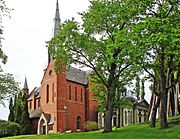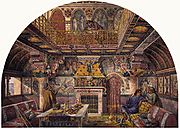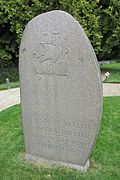Axel Haig facts for kids
Quick facts for kids
Axel Herman Haig
|
|
|---|---|
 |
|
| Born |
Axel Herman Hägg
10 November 1835 |
| Died | 23 August 1921 (aged 85) |
| Known for | Art (drawing, etching), architecture |
| Movement | Gothic Revival |
Axel Herman Haig RE (Swedish: Axel Herman Hägg; 10 November 1835 – August 23, 1921) was a talented artist, illustrator, and architect from Sweden. He lived from 1835 to 1921. His beautiful paintings, drawings, and etchings made him very famous. He worked for himself and for many important architects during the Victorian era. People even called him "the Piranesi of the Gothic Revival" because his detailed art was so special.
Contents
Axel Haig's Early Life and Training
Axel Haig was born on November 10, 1835. His family lived on a farm called Katthamra in Östergarn, on the island of Gotland, Sweden. His father, Axel Hägg, owned land and sold timber. His mother was Anna Margaretha Lindström.
When he was young, Haig learned to draw and paint with watercolors. His teacher was Per Arvid Säve, who had a special drawing school in Visby. Later, Haig began training to be a shipbuilder. He worked at the government shipyard in Karlskrona. In 1856, he traveled to Glasgow, Scotland. There, he continued his training with a shipbuilding company.
However, Haig became more interested in architecture. In 1859, he started a new apprenticeship. He trained as a draughtsman, someone who draws plans for buildings. He worked for the Ecclesiastical Commissioners for seven years. After that, he decided to become an independent architectural artist.
How Architectural Competitions Shaped His Career
The mid-1800s was a time of great change in England. The British Empire was growing, and the Industrial Revolution brought a lot of wealth. This meant many new buildings were needed. Cities wanted new government offices, town halls, and churches. Railway stations were also being built.
Architects would compete to get these big projects. They needed skilled artists to draw their building plans. These drawings helped judges see what the finished buildings would look like.
In 1866, Haig met a famous architect named William Burges. Burges hired Haig to draw his designs for the Royal Courts of Justice in London. Haig created stunning watercolor pictures. These drawings were an "immediate sensation," meaning everyone loved them. The architect who won the competition, George Edmund Street, even said he didn't mind losing to such amazing drawings.
Working with William Burges
Haig and Burges worked together until Burges passed away in 1881. During this time, they created some of the most amazing medieval-style designs of the Victorian Gothic Revival. The Gothic Revival was a popular style that brought back ideas from medieval architecture.
Haig drew many of Burges's most important buildings. These included Cardiff Castle and Knightshayes Court. He also drew designs for churches like the Church of Christ the Consoler. Other projects included Castell Coch and plans for Saint Paul's Cathedral. People said that Haig was the perfect artist for Burges's "medieval dreamland" designs.
Haig's Etchings and Later Works
Axel Haig also became a successful etcher. Etching is a type of printmaking where you scratch a design onto a metal plate. His drawings and prints of European castles, palaces, landscapes, and cathedrals became very popular. He was even chosen to be a member of the Royal Society of Painter-Etchers.
Haig lived mostly in England, but he spent his summers at his family farm in Gotland, Sweden. He also helped restore and rebuild Floda Church in Sweden between 1885 and 1888. He based the work on his own drawings.
Haig also designed All Saints' Church, Grayswood in Surrey, England. It was built between 1901 and 1902. The church has a unique style, mixing local building traditions with Gothic and Arts and Crafts elements. Axel Haig is buried in the churchyard there. The church is now a Grade II listed building, meaning it's an important historic site.
In 1921, the year Haig died, Maurice Adams wrote about his work. He said that Haig's architectural drawings were among the best of his time. He also noted that Haig's artistic skill was truly unique.
Gallery
-
Haig's illustration for the Summer Smoking Room at Cardiff Castle





